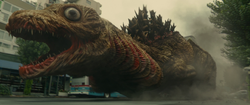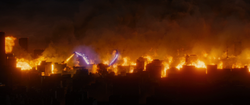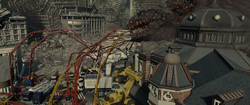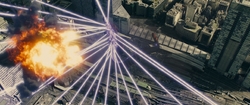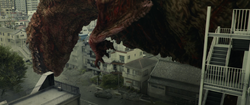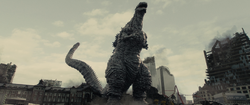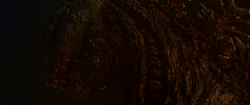Template:Tabber2PostMillennium Template:Infobox MonsterThe Godzilla (ゴジラ Gojira?) of the Shin Godzilla continuity was the first in the Toho reboot series of films.
This incarnation of the monster first appeared in the 2016 film, Shin Godzilla, and as this continuity serves as a series reboot, this Godzilla is the first within its continuity, with no monster, or monster related events preceding it.
Name
During the events of the movie, the name Gojira comes from Goro Maki's referral to him as such. At his home of Odo Island, this term means "Incarnation of God". On top of the Japanese native name given to the newly discovered creature, Maki also gave him the English name of "Godzilla".
This English translation was adopted by the Department of Energy, and was referred to as the "DOE's codename".
Throughout the film's running time, Godzilla's multiple forms are never given specific names, and are just referred to by numbered titles, such as the "fourth form".
Design
Appearance
Godzilla's appearance changes multiple times over the course of the film due to the creature's incredible evolutionary capacity.
The first form only shows its tail during the beginning of the movie. It's large, and very much resembles the second form's tail in regards to aesthetic, being yellow-hued, with a frayed end. The first form did not have the physical nor physiological conditions to withstand being on land as many sea creatures are often crushed by their own weight if they even attempt to make landfall, including mammals such as whales.
The second form is very much reminiscent of a moray eel or frilled shark, having a long body, neck, and tail, while also possessing stubby, undeveloped hind legs for land movement, and stubs on its chest that are shown to be underdeveloped arms. Unlike Godzilla's later forms, this form possesses a sickly yellow complexion, with red, exposed muscle on its back and shark-like gills that frequently bleed, showing that it struggles to breathe outside the water. The dorsal plates of this design are underdeveloped, much like its other body parts. The eyes of this design are also very large in relation to its body, almost resembling that of the colossal squid in appearance. Too weak to stand up, it moves by wriggling on its belly, pushing itself forward with its stubby hind legs and thrashing its tail.
The third form of Godzilla is very much like traditional incarnations in regards to appearance. This form is bipedal, with stronger, more developed hind limbs and the ability to assume a stance much like modern Godzilla, possesses small forelimbs and a long neck in relation to its body. Unlike his second form, which possesses a sickly yellow skin tone, the change in appearance for this form altered the skin tone of Godzilla to a dark orangey-red, with exposed muscle changing from a red, to a glowing orange. The scutes of the design also become more defined and larger with this evolution. In this form, heat can be visibly seen from its fins, meaning its mutation consumed much energy and produced a lot of heat. Its gills also have shrunk and closed up, suggesting that this form has now adapted to breathe on land. Despite being bipedal, its legs had not fully developed, causing its legs to noticeably shake as it struggled to not to fall while it was walking. However, its legs were enhanced enough to allow it to move fast enough to run, compared to the second form's slithering and the third form's initial stumbling. When it started to overheat, it reverted to the stance of its second form to more quickly retreat to the ocean.
The fourth and final form of Godzilla is very much akin to other traditional designs, being fully bipedal, with a fully developed row of dorsal spines, and a much taller height in comparison to his prior form. The shade of skin for this form is a much darker black color, with red, glowing highlights around exposed areas of the body, such as his neck, back and legs.
This form's head possesses no cheeks or lips, and multiple rows of jagged, gnarled teeth which protrude in and out of the skin around his mouth, a pronounced nose with large round nostrils, small white, seemingly-lidless eyes and a jawline that extends widely all the way to the sides of his head. In addition, the eyes have a brille, a protective lens, in place of traditional eyelids that can protect its eyes from harm. The brille is strong enough to resist bombs being dropped on its face. His lower jaw is similar to that of a snake, and on top of being able to open widely to more than an unsettling 90 degrees is also able to split open when Godzilla uses his iconic atomic breath during the movie.
Adding to the differences is his arm to body ratio, with small arms that barely reach out past his chest and remain mostly immobile in the movie, bar a few movements from his fingers.
Unlike most Godzillas prior to this one, this Godzilla's tail is very long, and consistently hangs around and above his head. Inside his tail is a giant human-like skull. His tail also happens to be where he spawns multiple copies of his next evolutionary form.
Godzilla's fifth form take on an eerily human shape, with Godzilla-like dorsal plates running up their spines. Models for the evolution show they lack eyes, despite concept art of the design originally possessing them, and a large divide runs down their cranium.
Like its predecessor form, the humanoid forms aren't muscular, and appear to be very emaciated, with a large hole present in their chests.
Godzilla's atomic breath underwent an aesthetic makeover for the film. It's very thin in comparison to prior Godzilla incarnations which tended to be wide beams of concussive energy, with the same traits being passed onto his dorsal spines. Behind the scenes videos for the film also show how his atomic powers changed in development, ranging from hyper-thin beams to slightly transparent incarnations of the current film's beams.
Portrayal
Godzilla is portrayed through the use of CGI and chroma keys in the film, aided by motion capture from Mansai Nomura in the case of the monster's fourth form. Initially, Godzilla's fourth form was to utilize a suit-like puppet that was manned by multiple members of the production crew by remote controls, and specifically placed wires. It was large, having been built in 1/38 scale to the actual creatue, and featured articulation in multiple areas, including the fingers, mouth, eyes, and spinal regions, allowing for a wide range of movement. The puppet was to be shot in front of a blue chroma key and inserted into scenes in the film, much like other practical effects for the monster.
This suit was later scrapped in favor of CGI and motion capture for an unknown reason, but the giant prop can be seen on special features for the film's Japanese Blu-ray release, being used as late as August, 2015. Interestingly enough, the first leaked reveals of the monster involved low resolution shots of this suit.
The second form was mostly portrayed by CGI, but also had some key sequences utilizing chroma keys and practical effects, including miniature sets and a roughly designed Godzilla head used for destroying them. These were utilized for shots of the second form pushing through houses.
The third form followed in the second's footsteps, using CGI primarily, while having some practical effects mixed into its actions. A good example of these practical effects include the third form's sprint through a building as it escapes, which causes mass destruction. This scene was composed of over nine individual shots of practical effects being used that was spliced together on top of a CGI backdrop.
The fourth form was primarily handled with CGI, with bodily movements being motion captured by Mansai Nomura. Mansai would be clad in a bodysuit, Godzilla mask, and a small set of dorsal plates, and walk around in a green chroma keyed room. To emulate the sensation of weight without being bound to a suit in the same fashion as the famous Haruo Nakajima, a large weight would be secured to Nomura's waist as he walked, giving Godzilla the slow, determined gait seen in the film.
Like the second form, practical effects were also utilized in small manners for the fourth. These would be seen when Godzilla steps on a large wall. Godzilla's foot would be inserted into the shot of the practical effect wall being destroyed, resulting in the film's final, convincing shot of destruction.
Godzilla's atomic breath also went through portrayal revisions in the film. Multiple behind the scenes videos show new physics tests for destruction involving the blowtorch-like beam, resulting in realistic collapses for structures. Unlike prior Toho films, the effects caused by the atomic beam weren't practical, and were mostly handled in a CGI environment, as seen in the video below.
Roar
Godzilla's roar in this film changes based on his form, however, not all forms are able to, or do roar. The first and second forms are vocally silent, likely due to the fact that at this point it still is unable to properly breathe on land.
The third form possesses the roar of the 1954 Showa era Godzilla. Interestingly enough, this Godzilla's '54 era roars have a noticeable audio overlap, making the middle part of the roar sound like it's repeating, whereas the original roar lacks this.
The fourth form utilizes the roar of the 1962 to 1975 Showa era Godzilla, and also possesses a roar akin to the Heisei era Godzilla, which it unleashes shortly before utilizing its atomic breath. Said Heisei-like roar is also heard in the North American trailers for the film.
Upon the culmination of Yaguchi's "Operation: Yashiori" in Godzilla's final seconds, he lets out the 1984 roar of the Heisei era Godzilla.
Personality
This Godzilla's personality is starkly different in regards to those coming before it, especially coming off the heels of Legendary's Godzilla. Rather than being openly heroic, antagonistic, or some shade of gray in between, Godzilla in this movie is outright detached from everything in the movie emotionally.
Over the course of the film and his raids on the multiple cities he travels through, Godzilla shambles forward slowly, but methodically, almost ignoring everything in his way, be it civilians, buildings, or the fire from a combined force of Japanese helicopters and tanks. With this, he shows no outright intentional hostile expressions. It is possible that this Godzilla is a mindless force of destruction, with no course of thought, emotion, or intent. Alternatively, it is also possible that he is in a constant state of pain, agony and suffering from its mutation and disfigurement, fitting the description that Godzilla "is equally a victim of the atomic bomb”.
Godzilla's zombie-like demeanor is only broken when bunker busters dropped onto his back physically harm him, resulting in a focused and enraged reaction towards his attackers. The same expression of reaction is also present when Operation: Yashiori is enacted, where Godzilla reacts in this manner towards the force attacking him once more, ultimately leading to his defeat.
Godzilla also displayed some intelligence as it reserved some energy in order to surprise attack the squadron of Japanese workers who attempt to inject it with coagulant.
Origins
The Godzilla in Shin Godzilla features a radically different origin story than its predecessors despite still originating from prehistoric creatures. Rather than being a prehistoric reptilian creature prior to being exposed to nuclear radiation, Godzilla is proposed to be an entirely new form of super-organism evolved from some kind of prehistoric marine animal that surrounded itself with nuclear waste dumped into its habitat on the sea floor.
As said creature became irradiated by the nuclear waste, it mutated to the point of developing the ability to withstand and even consume the radioactive material and evolved into a gigantic creature. The end result of this evolution was Godzilla, though other forms that this super-organism developed beforehand included an eel-like aquatic form and a bipedal theropod-like form. Even after Godzilla's seeming defeat, a new evolved form of his arose, being human-like in appearance, taking after the same organisms that defeated it in the first place.
History
As the Japanese coast guard investigates an abandoned yacht in Tokyo Bay, something in the water attacks their boat. Soon afterwards, the Tokyo Bay Aqua-Line is mysteriously flooded and collapses. After seeing a viral video showing a massive entity moving in the area, Japan's Deputy Chief Cabinet Secretary Rando Yaguchi is convinced that the incident was caused by a living creature. His theory is initially dismissed but later confirmed when news reports show a massive tail coming out of the ocean.
Later, a massive eel-like creature makes landfall, emerging from the water and causing havoc as it struggles to drag itself along the streets of Tokyo. Before evacuations can be done, the creature destroys everything in its path, causing major casualties, and suddenly begins to mutate, evolving into a form that stands on two legs before returning to the sea.
The top government officials focus on military strategy and civilian safety, while Yaguchi is put in charge of a task force to research the creature. Due to high radiation readings, the creature is theorized to be energized through nuclear fission. The US sends a special envoy, Kayoko Ann Patterson, who reveals that a disgraced zoology professor, Goro Maki, had been studying mutations due to radioactive contamination and theorized the appearance of the creature but the US covered it up. The yacht abandoned in Tokyo Bay had belonged to Maki and he had left his investigative notes there before disappearing. From those notes, it was revealed that the creature was originated from ancient micro-organisms that merges into singular superorganism due to surrounded by nuclear wastes.
The creature, now named Godzilla (呉爾羅 Gojira) after Maki's research, reappears, now twice its original size, and makes landfall near Kamakura en route for Tokyo. The Japanese Self Defense Forces are mobilized, but their attacks have no effect on Godzilla and they suffer major casualties. The US offers their intervention in exchange for full access to study the creature, and the Japanese government reluctantly agrees.
B-2 bombers sent by the US attack Godzilla with GBU-57A/B Massive Ordnance Penetrators (MOPs), but it is barely injured and responds with highly destructive atomic rays fired from its mouth and dorsal fins. The battle destroys a major part of Tokyo, along with both the US bombers and helicopters carrying most of the Japanese government officials. After depleting his energy, Godzilla enters a dormant state and becomes immobile.
Yaguchi's team discovers that Godzilla's fins and blood work as a cooling system, allowing them to theorize that through the use of a coagulating agent, they could trigger a reaction and cause Godzilla to freeze. Furthermore, after analyzing tissue samples, they find that Godzilla is able to survive as long as air and water are available due to both required as sustenance to synthesize radioactive isotope that provided him with energy, and that the creature is able to reproduce asexually due to Godzilla's regenerative ability so potent that any pieces that fall from his body would regrow into new Godzillas. The UN, headed by the US government and unaware of this weakness, informs Japan that the use of thermonuclear weapons against Godzilla is inevitable. Unwilling to see nuclear weapons detonated in Japan again, Patterson decides to use her political connections to buy Yaguchi's team as much time as possible to finish the plan, even if it puts her own career at stake.
Against international pressure and the lack of faith from the interim government, the team manages to procure enough coagulant and enacts their plan. They provoke Godzilla into using his atomic breath until its energy's depleted. The team then detonates explosives in the nearby buildings, knocking Godzilla down and allowing nearby tankers full of coagulant access into Godzilla's mouth, enabling the injection of the coagulant. Though many people are killed in the process, the team's plan succeeds and Godzilla is frozen solid.
In the aftermath, the international community agrees to call off the nuclear strike, but have the new Japanese government agree that, in the event of Godzilla's reawakening, a thermonuclear bomb will be launched at him. As Yaguchi ruminates on the future, the scene shifts to several human-like skeletal creatures protruding from the end of Godzilla's tail, implying that in his defeat he had begun to evolve once again.
Abilities
Amphibious lifestyle
In this continuity, Godzilla began as a prehistoric sea creature that fed on nuclear waste on the sea floor, causing it to evolve rapidly. When Godzilla finally came onto land, he possessed gills on the sides of his neck.
When Godzilla initially came ashore, these gills leaked red fluid, possibly his blood, likely suffocating in the air like a landed fish or a beached whale would. The gills closed and decreased in size as Godzilla grew and evolved further, but are still present and could be seen glowing whenever he charges his atomic breath. While the third form managed to solve the problems of breathing and locomotion on land, it still had not evolved a countermeasure to over-heating.
Godzilla was not truly amphibious until its fourth form was reached due to its underdeveloped "cooling system". When it went to land, its body produced too much heat and it had to retreat to the sea to cool itself down.
Atomic breath
In Shin Godzilla, Godzilla's atomic breath changes according to how he uses it and indicates how much power he has used up on firing it. He first calls upon the ability after being injured by American air strikes, much of his body begins to radiate a distinct bright red, that transitions into a violet-purple hue that is brightest at his dorsal plates, following which, he "vomits" a dark cloud of atomic smoke, that is spewed toward the ground that quickly spreads around the city.
Eventually, Godzilla ignites the atomic ashes with pure fire that results large portions of Tokyo are engulfed in flames. The atomic fire then slowly turns into a focused, purple beam than has overwhelming destructive power that doesn't just simply crumble nearby buildings, but is powerful enough to slice through multiple skyscrapers on a whim, bisecting entire skylines. After noticing the American planes coming back for another bombing run, he also transfers his energy through his dorsal plates, emitting several purple rays of similar destructive capacity, targeting both incoming bombs and close aircraft.
Later in the film, after Godzilla has been reawakened from a dormant state, drones are sent with the goal of distracting Godzilla and depleting some of his atomic energy. Godzilla responds to the drones with another volley of atomic rays from his dorsal plates, this lasts for a short while before he transfers the energy back through his mouth, and the tip of his tail, allowing both to fire independently. Before petering out, the rays briefly shift into a less intense stream of flame, signaling his gradual loss of energy.
The ray has a destructive power similar to the one seen in the Heisei series, albeit with less concussive force, not producing any explosions on impact but rather penetrating and vaporizing most of it's targets outright. It is very narrow and focused, almost identical to the sonic beams of Gyaos and able to easily and neatly slice through buildings. It was also explained in the movie that when he uses his dorsal rays, he can "control" or "direct" them to any target he desires due to Godzilla possessing "something like a built-in phased array radar" to "instinctively intercept approaching objects" so he won't have to waste too much energy to attack moving targets around him.
Durability
In the movie, Godzilla's regenerative ability proved to be very potent that any pieces of his flesh that broke off his body grew into starfish-like creatures. This enables him to reproduce asexually through either fission or even self-mutilation.
Godzilla is also immune to virtually all conventional weaponry, barely seeming to notice when he is attacked. However, Massive Ordnance Penetrator (MOP) bombs that struck Godzilla directly on his exposed back were able to injure him and cause him to bleed, albeit the loss of blood didn't seem to impact his performance.
Energy absorption and projection
In Shin Godzilla, Godzilla's capability to manipulate nuclear energy for offensive purpose is far more advanced than his predecessors, as he not only fires atomic breath from his mouth, but also through his dorsal fins in form of a salvo of atomic lasers and the tip of his tail as a means to attack multiple foes at the same time.
Physical adaptation
As shown in the film, Godzilla is able to physically alter his body and methods of attack based on his aggressors, as well as personal necessity. For example, when humanity's forces successfully attacked from above with bunker busters, Godzilla developed his mouth and dorsal-based rays which decimated his opposition. This ability also changed towards the end of the film and Godzilla began to fire his atomic beam from his tail over his spine, allowing for pinpoint accuracy.
On the flip side, Godzilla's appearance changed multiple times over the course of the film. His first visible change is the transition from his first to second form, where he changes his stance and appearance. His second change is not seen outright, but is the dramatic change from his third to fourth form, where he loses his orange-red skin tone and smaller stature, and becomes a deep black in coloration, with glowing red exposed parts of his body. Finally, the transition from his fourth to fifth form is seen briefly, where he goes from his traditional aesthetic, to that of a humanoid form. What became of this form, and of Godzilla is unknown.
It was noted and hypothesized that Godzilla could potentially shrink or grow wings for airborne locomotion, but these abilities were never displayed.
Godzilla's physical forms, including his fifth form were visually detailed in the book, The Art of Shin Godzilla.[1][2]
Weaknesses

|
SPOILER WARNING: This section may contain major plot and/or ending details. Proceed at your own discretion. |
|---|
Blood coagulant
During the events of the movie, the protagonist of the film, Rando Yaguchi and his team postulate that since he's a nuclear creature, Godzilla has to cool down his "nuclear reactor" somewhere in his body, and "rapid cooling of his blood may not kill him, but can immobilize him" leading to the team's conclusion that they can freeze Godzilla's blood, with the beast freezing as well, using a "Blood coagulating drug".
Yaguchi's team had some difficulties in making the formula but later in the film, they figure out how to make said drug and start production to make the preparations for "Operation: Yashiori", the plan to put the coagulant in Godzilla and render him immobile indefinitely. After producing enough coagulant, "Operation: Yashiori" was initiated. The operation takes place during the final battle of the film, where, after a multiple phase approach intended to weaken and lay Godzilla on the ground, a team of crane arms finally pumped the blood coagulant into the beast's mouth. The first attempt at applying the coagulant failed, due to Godzilla having spare power, which he used to blast the first team with his atomic breath.
Their efforts were not in vain however, as the 20% of their available supply they managed to inject drastically slowed his movements. The second attempt was successful in putting the remaining 80% of the coagulant in Godzilla. Initially, Godzilla rose again, but following a loud roar, Godzilla abruptly freezes, unable to move.
Yaguchi's team later on discovers that Godzilla's isotope has a half life of 20, and remarks that it will be gone completely in "two or three years" which spells good news for Tokyo citizens and aids greatly in moving residents back to their homes. Yaguchi later on states that "now man must co-exist with Gojira" and since Godzilla will not be frozen forever, states that "Now's not the time to quit, and things are still far from settled".
Limited radioactive energy
Unlike previous incarnations, this Godzilla seems to have a limit to how much nuclear energy he can use before he must enter a dormant state to restore his powers. For example, using his atomic breath in its focused purple beam seems to quickly deplete his radioactive power, requiring him to enter his dormant state.
This dormant state forces Godzilla into an immobile, statue-like form, which can also be his downfall as he can freeze in locations where his enemies can take advantage of the environment against him. If he fully depletes his energy, he must remain dormant for roughly 15 days to fully restore his energy. Although he doesn't seem to remain dormant for the entire 15 days. Once Godzilla accumulated enough energy, its skin will start to glow red and its eyes will open, although it may elect to remain immobile to speed up its recovery process.
Overheating
The monster's third form was vulnerable to severe overheating, as seen shortly after it physically changed into its third form. The heat generated was enough to distort the air around the monster, and resulted in it ceasing its land movement to cool down in the ocean. This problem was solved upon the fourth form's arrival, as it didn't suffer from these issues.
Slow speed
As Godzilla trundles along sluggishly, it takes a long time to traverse greater distances, allowing the human forces to predict its direction and evacuate in advance.
Future Shin Godzilla evolutions
The Nikkei Science December 2016 issue and Shin Godzilla Generation novel presents an alternative continuity were the fourth form was merely a beginning ("baby") and Godzilla continued to evolve. Future forms and consequences of these were noted, and it was pointed that extinction on the subcellular scale is necessary to defeat Godzilla.
These include the below aspects:
- Fifth form
- Acquires flight ability.
- Self-division without limits.
- Divided forms shrink in size and form a legion.
- Became immune to the Yashiori Plan.
- Lost algesia (sensitivity to pain) and emotions.
- Self-generation of a completed form from the tiniest fragment of the body.
- Sixth form
- Overcame requirements of air and water to survive.
- Achieved personal energy production.
- Achieved limitless nuclear fusion and overcame limited energy problems.
- Degeneration of the mouth and teeth.
- Invaded outer space and reached other planets.
- Seventh form
- Contained a small universe within its body.
- Synthesized any materials and elements and made them its own.
- Adapted to any environment of the universe.
- Eighth form
- Transcended physical law and reached the "level of GOD" (and immortality).
- Fifth form
Trivia
- The Art of Shin Godzilla revealed that Godzilla's second form possesses 108,764,238 polygon in its CG model. The fourth form possesses 316,902,016 polygons.
- Yashiori of Operation:Yashiori is the name of strong sake to weaken Orochi in Japanese mythology.
- The Shin Godzilla is the first truly "new" Japanese Godzilla: while the series rebooted in the Heisei series and several times in the Millennium series, it always held the original 1954 as shared canon, while the 2016 film ignores that film and creates a whole new backstory and origin for Godzilla.
- While the production team originally tried to make Godzilla's texture seem like a real animal's, it was insisted by the directors that they give it a feel and texture like a rubber suit, a decision that ironically made the all-CGI Godzilla actually look more convincing in a live-action environment.
- The second form, affectionately dubbed "Kamata-kun" by fans, gained a cult following on the internet for its funny-looking appearance which many found somewhat adorable.
- At 118.5 meters in height, this incarnation of Godzilla is the second tallest incarnation so far within the films, originally surpassing the Legendary version which held the previous record before it by about 10 meters in height. It was outclassed by Godzilla Earth, which was confirmed to be even taller than the Shin Godzilla incarnation, coming in at 300+ meters tall.[3]
- Its focused atomic ray is very similar to that of Gyaos from the Gamera films, being thin and powerful enough to neatly slice a building in half.
- This version of Godzilla is unusually silent compared to other incarnations, which instead of roaring and stomping about instead quietly and slowly marches onward in a path of destruction.
- This Godzilla may be viewed as the polar opposite of the Legendary Godzilla:
- The Legendary Godzilla is designed to look noble, mighty, and regal, while the Shin Godzilla is designed to look gruesome, twisted and horrifyingly deformed.
- The Legendary Godzilla is portrayed as a bringer of order and a primordial balancing force of nature, while the Shin Godzilla is portrayed as a bringer of chaos and an abominable by-product of violations against nature.
- The Legendary Godzilla is more benevolent and peaceful compared to most portrayals of Godzilla, while the Shin Godzilla is more malevolent and destructive than most Godzilla depictions.
- The Legendary Godzilla's appearance and powers were designed to be more "believable" and "realistic", while the Shin Godzilla exaggerates the features and abilities of an unnatural monster.
- Interestingly, it was revealed in 2012 that a memo named Shin Godzilla was left by Ishiro Honda; he was planning to create a Godzilla to self-divide, and coalesce enemies and grow larger, enabling aerification and solidification, and the ability to become inanimate.[4]
List of appearances
Films
- Shin Godzilla (First appearance)
Video games
Books
- The Art of Shin Godzilla
- Nikkei Science December 2016 Issue
- Shin Godzilla - Generation
- Toho SFX Movies Authentic Visual Book - Volume 2 - Godzilla (2016)
- Shin Godzilla vs. Evangelion brochure
References
- ↑ Riehiko, Nakajima (December, 2016). シン・ゴジラの科学 Nikkei Science. Retrieved June 11, 2017
- ↑ (2017). シン・ゴジラ GENERATION, ISBN: 9784798614175 Hobby Japan. Retrieved June 11, 2017
- ↑ (June 13, 2017).アニメ映画「GODZILLA」新ビジュアルで歴代最大サイズのゴジラが初披露! Eiga. Retrieved June 17, 2017
- ↑ @maGuremono (January 19, 2017). 2012年にNHK BSPで放映された本多猪四郎監督に関する傑作ドキュメンタリー『イノさんのトランク』。終盤に晩年記したゴジラ新作構想メモが出てくるが、表題が『新(神?)ゴジラ』で「(相手を合体して)大きくなる」「分化。ゴジラ数匹発生」など、シン・ゴジラにも通ずるアイデアが。 Twitter. Retrieved June 11, 2017
Template:FilmKaijuNavbox



























